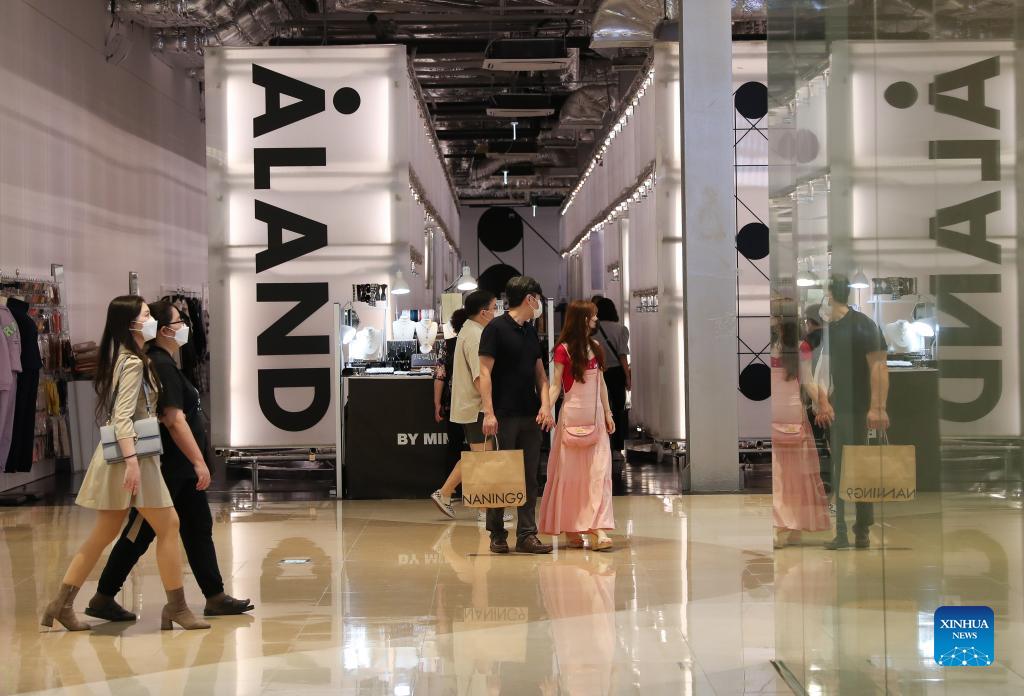
People wearing face masks walk in a shopping mall in Hanam, South Korea, Sept. 24, 2021. South Korea's daily COVID-19 cases hit a new record high as mass migrations of people visited hometowns during the Mid-Autumn holiday, which led to a rapid spread of the virus across the country, the health authorities said Friday. In the latest tally, the country reported 2,434 more cases of COVID-19 for the past 24 hours, lifting the total number of infections to 295,132, according to the Korea Disease Control and Prevention Agency (KDCA). It marked the country's highest daily caseload since the first case was found here in January last year. The previous high was 2,221 tallied on Aug. 11. (Xinhua/Wang Jingqiang)
SEOUL, Sept. 24 (Xinhua) -- South Korea's daily COVID-19 cases hit a new record high as mass migrations of people visited hometowns during the Mid-Autumn holiday, which led to a rapid spread of the virus across the country, the health authorities said Friday.
In the latest tally, the country reported 2,434 more cases of COVID-19 for the past 24 hours, lifting the total number of infections to 295,132, according to the Korea Disease Control and Prevention Agency (KDCA).
It marked the country's highest daily caseload since the first case was found here in January last year. The previous high was 2,221 tallied on Aug. 11.
The daily caseload was sharply up from 1,715 in the prior day following the Chuseok holiday, a South Korean version of Thanksgiving Day that continued through Wednesday.
Millions of people migrated to their hometowns during the traditional holiday when families had gathered together to share newly harvested food and give thanks to ancestors.
For this year's holiday, the government temporarily eased the social-distancing rule to allow up to eight family members and relatives, including four fully vaccinated ones, to gather at the same house in the Seoul metropolitan area.
The Seoul capital area has been under the highest Level 4 social-distancing guideline, which bans private gatherings of seven or more people at restaurants, cafes and homes.
Among the total domestic cases, the Seoul metropolitan region accounted for 72.3 percent or 1,747 cases.
Of the new cases, 903 were Seoul residents. The number of newly infected people residing in Gyeonggi province and the western port city of Incheon was 704 and 140.
The virus spread also raged in the non-metropolitan region. The number of new infections in the non-capital areas was 669, or 27.7 percent of the total local transmission.
Eighteen cases were imported from overseas, lifting the combined figure to 14,275.
The health authorities warned that the daily caseload could rise further in the coming days amid the growing PCR tests taken among those who returned to homes in the capital area and those who greeted families in non-capital areas.
The spread of the more transmissible Delta variant also boosted concern about the COVID-19 resurgence. The daily number of confirmed COVID-19 cases stayed above 1,000 for 80 days since July 7. The daily average tally for the past week was 1,885.
However, the higher vaccination rate may help slow the speed of the virus spread. The country's first-shot vaccination rate already topped 70 percent before the Chuseok holiday.
According to the latest data, 72.3 percent of the country's 52 million population was administered the first dose of COVID-19 vaccines, with 44.0 percent of the population being fully inoculated.
The government aimed to raise the vaccination rate further by announcing its plan next week to administer vaccines to those aged 12-17 and pregnant women during the October-December quarter.
Amid the ongoing vaccination campaign, the total fatality rate from the pandemic stood at a relatively low level of 0.82 percent. Enditem